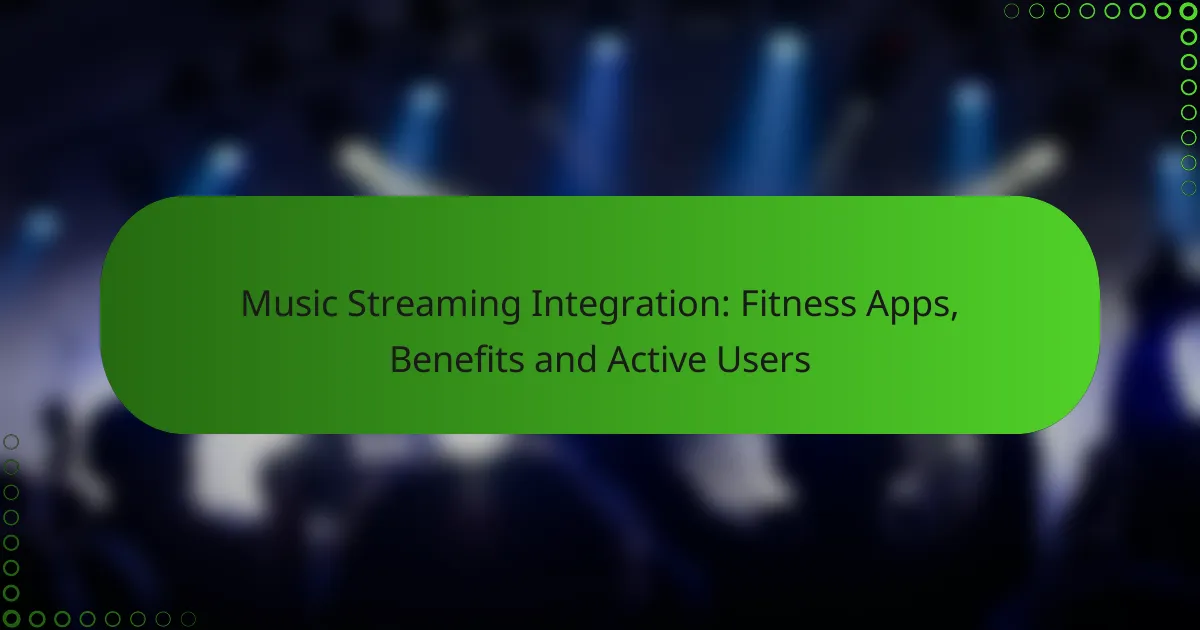Fitness apps are increasingly integrating music streaming services, allowing users to access their favorite playlists and tracks seamlessly during workouts. This integration not only enhances the exercise experience by providing personalized music options but also fosters motivation and social interaction among active users. As a result, individuals who prioritize fitness can enjoy improved performance and a more engaging fitness journey.

How do fitness apps integrate music streaming services?
Fitness apps integrate music streaming services by allowing users to access their favorite playlists and tracks directly within the app. This seamless connection enhances the workout experience by providing personalized music options that can motivate and energize users during their exercise routines.
Integration with Spotify
Fitness apps often integrate with Spotify through APIs that allow users to connect their accounts and access playlists. Users can create workout-specific playlists or choose from curated lists designed for various types of exercise, such as running or yoga.
When using Spotify with fitness apps, users should ensure their Spotify account is linked properly to avoid interruptions. Some apps may offer features like automatic playlist updates based on workout intensity, which can enhance motivation.
Integration with Apple Music
Apple Music integration in fitness apps enables users to stream their music library directly while tracking workouts. Users can access their existing playlists or create new ones tailored for specific fitness activities.
To make the most of this integration, users should familiarize themselves with the app’s settings to customize their listening experience. It’s also beneficial to download playlists for offline use, especially for outdoor workouts where connectivity may be limited.
Integration with YouTube Music
YouTube Music can be integrated into fitness apps, allowing users to enjoy a vast array of music videos and tracks during their workouts. This integration often includes features like background play, enabling users to listen while tracking their exercise metrics.
Users should be aware that streaming video content may consume more data, so downloading music for offline listening can be a practical option. Additionally, some fitness apps may offer curated workout playlists from YouTube Music to enhance user engagement.
Integration with Amazon Music
Fitness apps that integrate with Amazon Music provide users access to a large catalog of songs and playlists designed for workouts. Users can easily link their Amazon Music accounts and select tracks that match their exercise routines.
To optimize this integration, users should explore Amazon Music’s workout playlists and consider creating custom playlists that align with their fitness goals. It’s also wise to check for any subscription requirements, as some features may be limited to Amazon Music Unlimited subscribers.

What are the benefits of music streaming in fitness apps?
Music streaming in fitness apps enhances the workout experience by providing motivation, personalization, and social interaction. These benefits can lead to improved performance and a more enjoyable fitness journey.
Enhanced workout motivation
Integrating music streaming into fitness apps significantly boosts workout motivation. Upbeat and energetic tracks can energize users, making them more likely to push through challenging exercises.
Fitness apps often curate playlists that align with specific workout intensities, helping users maintain their pace. For example, high-tempo songs can be used for cardio sessions, while slower tracks may accompany yoga or stretching routines.
Personalized playlists
Personalized playlists allow users to tailor their music selection to their preferences, enhancing their overall workout experience. Fitness apps often analyze user behavior and preferences to suggest songs that match their tastes.
This customization can include genre preferences, favorite artists, or even mood-based selections. Users can create their own playlists or rely on algorithm-generated ones, ensuring they have the right soundtrack for every workout.
Improved workout performance
Listening to music during workouts can lead to improved performance by increasing endurance and reducing perceived exertion. Studies suggest that music can distract from fatigue, allowing users to work out longer and harder.
Fitness apps that incorporate music streaming can help users find the right tempo to match their exercise rhythm, which can enhance efficiency. For instance, running at a pace that matches the beat of a song can lead to better timing and speed.
Social sharing features
Social sharing features in fitness apps enable users to share their favorite playlists and workout experiences with friends. This not only fosters a sense of community but also encourages accountability and motivation among users.
Many apps allow users to connect with friends or join groups, where they can share music recommendations and workout achievements. This social aspect can enhance user engagement and make fitness more enjoyable.

Who are the active users of fitness apps with music streaming?
Active users of fitness apps that integrate music streaming typically include individuals who prioritize fitness and enjoy listening to music while exercising. These users often seek motivation and enhanced performance through curated playlists and personalized music recommendations.
Demographics of active users
The demographics of active users of fitness apps with music streaming are diverse, but they often skew towards younger adults, particularly those aged 18 to 34. This group includes both men and women who are tech-savvy and regularly engage in physical activities such as running, cycling, and gym workouts.
Additionally, many active users are urban dwellers with disposable income, allowing them to invest in premium app subscriptions that offer enhanced music features. This demographic is increasingly influenced by social media trends and fitness culture.
Usage patterns among fitness enthusiasts
Fitness enthusiasts typically use music streaming within their fitness apps to enhance their workout experience. Many users report that they listen to music for motivation, with playlists often tailored to specific workout types or intensities.
Common usage patterns include streaming music during cardio sessions, strength training, and group classes. Users may also create personalized playlists or select from pre-made ones, adjusting their music choices based on their workout goals and preferences.
Trends in user engagement
Trends indicate that user engagement with fitness apps featuring music streaming is on the rise, particularly as more people seek ways to stay motivated during workouts. Features like social sharing, challenges, and integration with wearable devices are becoming increasingly popular.
Moreover, the rise of virtual fitness classes has led to higher engagement levels, as users enjoy the combined experience of guided workouts and music. As technology evolves, the integration of AI-driven music recommendations is expected to further enhance user satisfaction and retention.

What criteria should be considered when choosing a fitness app with music streaming?
When selecting a fitness app that integrates music streaming, consider compatibility with your devices, the size of the music library, and the overall user interface and experience. These factors will significantly influence how well the app meets your fitness and entertainment needs.
Compatibility with devices
Compatibility is crucial for a seamless experience. Ensure the fitness app supports your smartphone, smartwatch, or fitness tracker. Many apps are designed for iOS and Android, but check for specific device requirements, especially for wearables.
Additionally, consider whether the app can connect to other devices like Bluetooth headphones or speakers. This connectivity enhances your workout experience by allowing you to enjoy music without interruptions.
Music library size
The size of the music library can greatly affect your motivation during workouts. Look for apps that offer a diverse range of genres and playlists to keep your sessions fresh and engaging. A larger library allows for more personalized workout playlists.
Some apps may also provide curated playlists tailored to specific workout types, such as running or yoga. This feature can help you find the right tempo and energy level for your activities.
User interface and experience
A user-friendly interface is essential for a smooth experience while exercising. The app should be easy to navigate, allowing you to quickly switch between workouts and music without distraction. Look for apps that offer customizable settings to suit your preferences.
Consider how the app displays information during workouts, such as metrics and song titles. A clean layout with clear visuals can enhance your focus and enjoyment, making your fitness journey more effective and enjoyable.

What are the emerging trends in music streaming integration for fitness?
Emerging trends in music streaming integration for fitness focus on enhancing user experience through personalized and interactive features. These innovations aim to motivate users and improve workout efficiency by seamlessly blending music with fitness activities.
AI-generated playlists
AI-generated playlists are tailored music selections created using algorithms that analyze user preferences, workout types, and even heart rate data. These playlists adapt in real-time, ensuring that the music matches the intensity and rhythm of the workout, which can enhance motivation and performance.
For example, a user engaging in a high-intensity interval training (HIIT) session might receive fast-paced tracks during intense intervals and slower songs during rest periods. This dynamic adjustment can lead to a more engaging and effective workout experience.
Collaborative workout sessions
Collaborative workout sessions allow users to connect with friends or fitness communities while streaming music together. This feature fosters a sense of camaraderie and accountability, making workouts more enjoyable and motivating.
Fitness apps may offer options for users to create shared playlists or synchronize music during group workouts, enhancing the social aspect of exercising. Users can join virtual classes where instructors curate playlists that align with the session’s goals, creating a unified experience.









